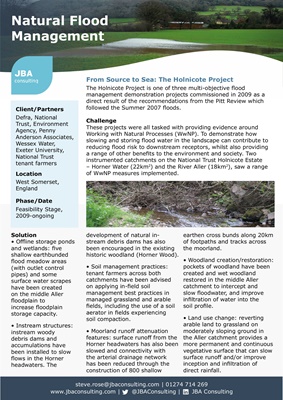
development of natural instream debris dams has also
been encouraged in the existing
historic woodland (Horner Wood).
• Soil management practices:
tenant farmers across both
catchments have been advised
on applying in-field soil
management best practices in
managed grassland and arable
fields, including the use of a soil
aerator in fields experiencing
soil compaction.
• Moorland runoff attenuation
features: surface runoff from the
Horner headwaters has also been
slowed and connectivity with
the arterial drainage network
has been reduced through the
construction of 800 shallow
earthen cross bunds along 20km
of footpaths and tracks across
the moorland.
• Woodland creation/restoration:
pockets of woodland have been
created and wet woodland
restored in the middle Aller
catchment to intercept and
slow floodwater, and improve
infiltration of water into the
soil profile.
• Land use change: reverting
arable land to grassland on
moderately sloping ground in
the Aller catchment provides a
more permanent and continuous
vegetative surface that can slow
surface runoff and/or improve
inception and infiltration of
direct rainfall.
River
restoration
From Source to Sea: The Holnicote Project
Client/Partners
Defra, National
Trust, Environment
Agency, Penny
Anderson Associates,
Wessex Water,
Exeter University,
National Trust
tenant farmers
Location
West Somerset,
England
Phase/Date
Feasibility Stage,
2009-ongoing
steve.rose@jbaconsulting.com | 01274 714 269
www.jbaconsulting.com | @JBAConsulting | JBA Consulting
The Holnicote Project is one of three multi-objective flood
management demonstration projects commissioned in 2009 as a
direct result of the recommendations from the Pitt Review which
followed the Summer 2007 floods.
Challenge
These projects were all tasked with providing evidence around
Working with Natural Processes (WwNP). To demonstrate how
slowing and storing flood water in the landscape can contribute to
reducing flood risk to downstream receptors, whilst also providing
a range of other benefits to the environment and society. Two
instrumented catchments on the National Trust Holnicote Estate
- Horner Water (22km2) and the River Aller (18km2), saw a range
of WwNP measures implemented.
Solution
• Offline storage ponds
and wetlands: five
shallow earthbunded
flood meadow areas
(with outlet control
pipes) and some
surface water scrapes
have been created
on the middle Aller
floodplain to
increase floodplain
storage capacity.
• Instream structures:
instream woody
debris dams and
accumulations have
been installed to slow
flows in the Horner
headwaters. The